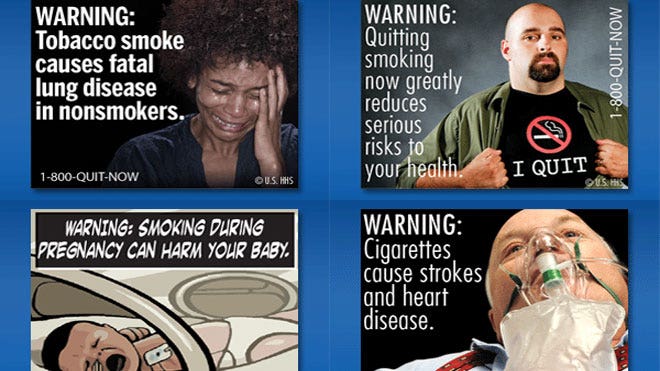FOXBusiness
-
 U.S. Food and Drug Administration
U.S. Food and Drug Administration
Everyone knows that smoking is bad for you, but the government has decided the situation is so dire that consumers who want to light up need to be greeted with a dead man on an autopsy table.
A federal appeals court heard arguments on Tuesday and is considering the constitutionality of the government’s requirement that cigarette packs carry graphic warning labels, which include diseased lungs and gums and a cadaver on an autopsy table.
In 2009, lawmakers passed the Family Smoking Prevention and Tobacco Act that gives the Food and Drug Administration more authority over the tobacco industry. The statute gives the FDA the power to regulate the sale and distribution of tobacco products, as well as the ability to require new warning labels, prohibit certain marketing tactics and reduce nicotine levels.
Tobacco companies, including R.J. Reynolds Tobacco Co. (RJR), Lorillard (LO: 136.06, -0.07, -0.05%) and Commonwealth Brands, filed a lawsuit later that year saying the FDA’s regulations impose on their freedom of speech. The law requires warning labels in color that cover the top 50% of a cigarette pack’s front and back panels. The law also requires the top 20% of any print advertisements to have a graphic warning. Right now, cigarette packages have a black-and-white written warning in a small box.
Lawyers for the tobacco companies also argue that the nine proposed images extend beyond providing factual information and serve as an anti-smoking advocacy platform. The new images were supposed to go in effect in September.
Dan Jaffe, group executive vice president of government relations for the Association of National Advertisers, which filed an amicus brief in the case, said people are aware of the dangers of tobacco products, and the government’s warning requirements overstep its power.
“Just because people are not acting in the way it wants, the government cannot control what is said about a product. They can’t put their thumbs on the scale to manipulate speech to try and force people to act in the way the government thinks is important.”
The government says the picture requirements are factual and are necessary to warn consumers about the risks of smoking and will discourage people from starting the habit and encourage smokers to quit.
“Every two successes [of quitting] saves one life; we are talking about tremendous public health benefits,” said Richard Daynard, a law professor at Northeastern University. He added that kids don’t start with generic cigarettes, they pick up the brands they’ve seen marketed as cool, but if they now see consequences of the habit, it acts as a deterrent.
“When they buy their first pack of cigarettes or see someone else’s pack on the counter, if they are disgusted with the image that is a good thing — we want to protect our kids from a deadly drug addiction.”
A U.S. district judge ruled in favor of the tobacco companies in February, saying the labels were too obtrusive and violated the companies’ First Amendment free-speech rights. He added that there were other ways the government could deter people from picking up the habit.
“The proposition that they have put forward is really extraordinary,” said Jaffe. “They can require companies of legal products to put on a message that they pay for to try and convince people not to buy the product.”
In his ruling, U.S. District Judge Richard Leon wrote that the images were “neither designed to protect the consumer from confusion or deception, nor to increase consumer awareness of smoking risks. Rather, they were calculated to evoke a strong emotional response calculated to provoke the viewer to quit or never start smoking.”
The Justice Department appealed this ruling, and in March, the Sixth Circuit Court of Appeals ruled that the law giving the FDA the power to regulate advertising on tobacco products was legal.
In a statement to FOX Business, American Medical Association President Peter Carmel said the association supports the graphically-explicit warning labels on cigarettes.
“These labels are an important component of a comprehensive tobacco control strategy to discourage youth smoking initiation, encourage youth and adult smoking cessation and protect people from secondhand smoke exposure.”
Warnings on cigarette packages have been around for 40 years, and the U.S. would be joining an estimated 30 countries by requiring graphic warnings. (Canada was the first country to require large image labels, starting in 2000.)
“It’s not as if we are starting from scratch. Some American judges tend to think it’s embarrassing to acknowledge the rest of the world exists and its possible to learn from that,” said Daynard.
Many experts expect the legal battle to end up at the U.S. Supreme Court because of the differing rulings in the lower courts. The tobacco industry is no stranger to litigation, and while it has lost some political clout on Capitol Hill, Jaffe argues this is a clear case of freedom of speech being impeded.
“A lot of people feel tobacco is such a bad product that anything should be allowed, but the Supreme Court has made very clear, in a large number of cases, it is dangerous for the government to start to really control what information is going to be provided as information to the public.”